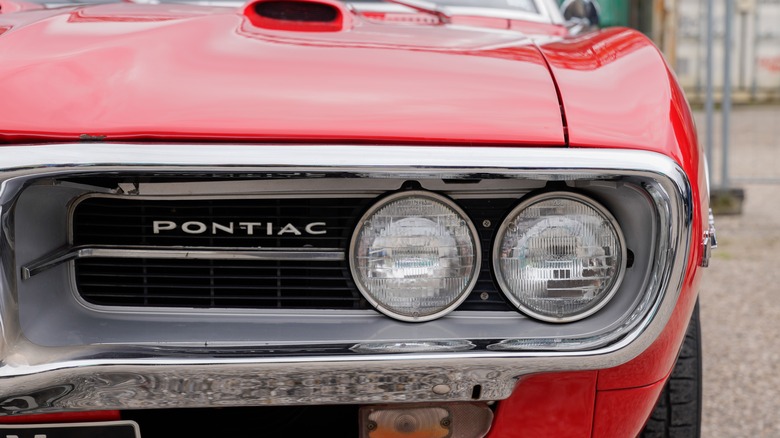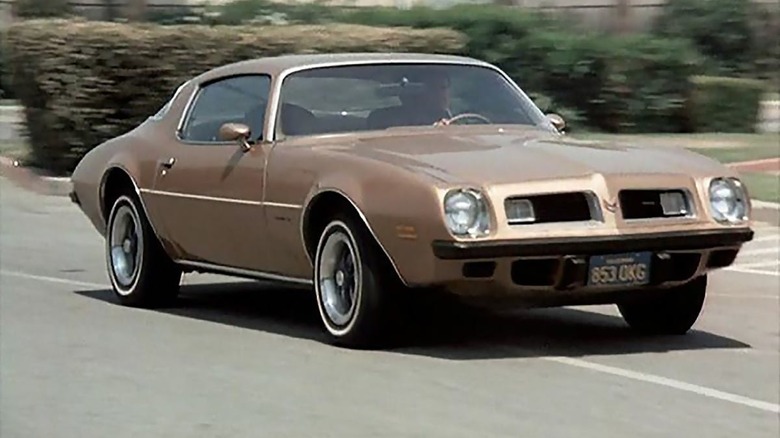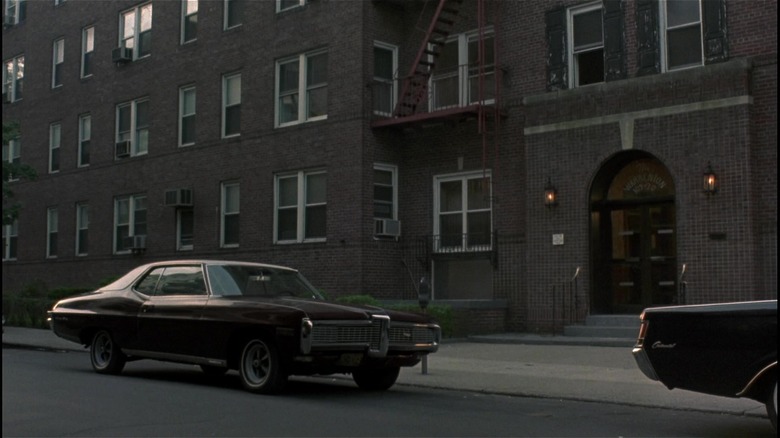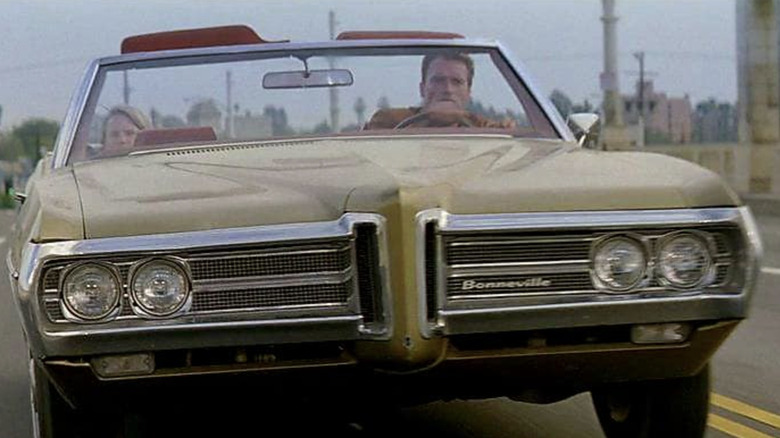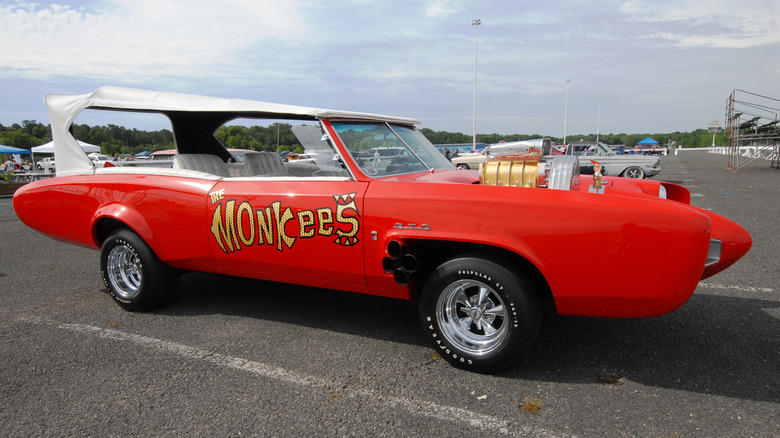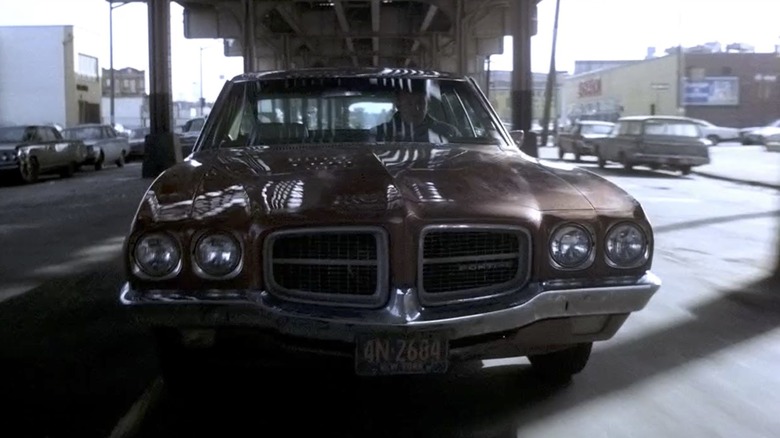5 Of The Most Popular Pontiacs From Movies And TV
Movies and television shows have long been a catalyst for making things incredibly popular, including the automobile. Over the decades, hundreds of cars have become indelibly ingrained into American pop culture thanks to Hollywood's constant onslaught of entertainment.
The automobile is one of the inventions that's probably had more of an impact in the United States than in any other country thanks to its vastness. Trains (and eventually planes) were great for moving the masses from sea to shining sea. However, the advent of the horseless carriage brought a speedy and highly personal convenience previously unseen, and gave both those isolated by their rural location outside of growing cities and city dwellers confined to the concrete jungles the freedom to move about where and when they wanted. The link between the automobile and Americans can not be overstated — nor can their presence in movies.
Believe it or not, the first Pontiac rolled off the production line in 1926. While that model 6-27 never made it big in the movies, there've been many since then that did. There's a good chance the first popular Pontiac that comes to mind is likely the Trans Am, which has been front and center of several movies, not the least of which was the one driven by Burt Reynolds in Smokey & the Bandit. Or maybe it's the Trans Am driven by David Hasselhoff in Knight Rider. Whatever the case, the Trans Am is low hanging fruit and this list won't include a single one.
1974 Pontiac Firebird Esprit
James Garner starred in films and television for over six decades. He had 98 acting credits and was nominated for Best Actor in a Leading Role in the 1986 film "Murphy's Romance" with Sally Field. Garner died at the age of 86 in 2014.
During the height of his career, he played ex-con turned private investigator Jim Rockford on the TV show "The Rockford Files," which ran from 1974 until 1980. Interestingly, Garner was a big car buff and only took the role after producers agreed to let him do his own stunts. He also picked the car his character would drive – a Denver Gold colored 1974 Pontiac Firebird Esprit, which had a General Motors F-body platform and was powered by a 400 cubic inch 6.6 liter V8 with a four-speed manual transmission.
Garner said he chose the cheaper Esprit over the sexier Trans Am because it better fit Rockford's blue-collar character. He also believed it had superior handling, which was necessary for his character to pull off one particular "signature maneuver" that always seemed to make an appearance.
This stunt involved throwing the car in reverse and getting it up to 35 miles an hour before letting off the gas. He would then turn the wheel hard left while pulling up on the emergency brake. This locked up the wheels and spun the car 180 degrees in the opposite direction, allowing him to escape. Garner performed the J-turn so often during the show that it has since become known as "The Rockford Turn."
1968 Pontiac Grand Prix
The opening scene of "Goodfellas" tells you all you need to know about what the next two hours and twenty-five minutes of this iconic Martin Scorsese film has in store. It opens with Henry Hill (played by Rio Liotta), Tommy Devito (Joe Pesci), and Jimmy Conway (Robert De Niro) riding in silence in Hill's brown, white vinyl-topped 1968 Pontiac Grand Prix sporting sleek Rally II wheels. Suddenly, they all hear a noise coming from the rear of the car. Thinking he hit something, Hill pulls over and ... well, we'll leave this spoiler free so you can experience firsthand what comes next.
The Grand Prix as a model has some little-known facts that only hardcore car fans probably know about. The '68 Hardtop Coupe came with a number of different engine sizes ranging from a 400 cubic inch V8 with a 2-barrel carb and automatic three-speed Hydra-Matic shifter to a 428HO V8 equipped with a manual four-speed.
The film is based on a book by the real Henry Hill, an actual mobster in the Luchesse New York crime family. Interestingly, before any of these acclaimed actors are shown, you see the Grand Prix first. And while the film version of Hill drove a Pontiac, the real-life Hill actually preferred Buicks.
1969 Pontiac Bonneville Convertible
Arnold Schwarzenegger is a Hollywood legend and global pop culture icon. The one-time governor of California ("The Governator") is also a vehicle enthusiast who has owned several costly cars (like a Bugatti Veyron) and even a military tank, which he managed to get for free, no less.
In 1993, Schwarzenegger starred in "The Last Action Hero," an action movie that bombed spectacularly at the box office. It has since, however, become a cult favorite and is heralded as a satirical film that perfectly made fun of a genre that had become a parody of itself.
In the movie, Schwarzenegger drives an olive green 1969 convertible Pontiac Bonneville that is about as big and burly as the hero himself. While this make and model looked good when paired with the right paint and options, this land-yacht sized Bonneville was anything but dazzling, which was unusual for cars driven by many "action heroes" from the era (i.e., the modified 1950 Mercury driven by Sylvester Stallone in "Cobra"). The stock Bonneville, convertible complete with white wall tires, typically was powered by a naturally aspirated 428 cubic inch V8 with a Rochester 4-barrel carburetor, and a manual three speed.
Despite its 223.5-inch length and a hefty curb weight of 4,109 pounds, it could still accelerate from zero to 60 mph in 6.7 seconds and cross a quarter mile in 15.2 seconds. According to Hagerty, it appears that the Bonneville sometimes gets swapped out for a Catalina throughout the film.
1966 Pontiac GTO Monkeemobile
The 1960s gave us some of the wackiest television of all time. One of those was "The Monkees," a show about a fictional four-man band trying to strike it rich in the music industry. The whole premise was inspired by the Beatles song, "A Hard Day's Night," and in fact turned the mock musicians into one of the top-selling real-life bands in the history of popular music.
Ironically, the show's theme song starts with the lyrics, "Here we come, walking down the street ... gettin' the funniest looks, from everyone we meet," because their mode of transport definitely got funny looks when it rolled down the street. The Monkeemobile was the brainchild of Dean Jeffries, one of Hollywood's legendary custom car designers and builders and the man behind many of film and TV's most iconic rides.
The Monkeemobile was built using a 1966 Pontiac GTO, but had so much custom work done that you'd never know it was a GTO. Jeffries cut off the roof and replaced it with a phaeton canvas top. He extended the front and made it look almost shark-like while cutting out part of the hood to make room for a GMC supercharger. He stretched the back and used the trunk space to create a booth-like seating area. Quad side pipes poked out from behind each front tire. Last but not least, a dragster parachute was attached to emphasize this car was not monkeying around. It was so popular that MPC Models created a 1/25 version that sold over seven million kits.
1971 Pontiac LeMans Hardtop Sedan
"The French Connection" won several Oscars in 1972, including Best Picture and Director. Additionally, Gene Hackman won Best Actor, an award his co-star Roy Scheider was also nominated for (but didn't win). Besides that, it has since earned the honor of having one of the most scintillating car chases ever filmed, and that's where our next Pontiac — a stock brown 1971 LeMans sedan — comes into play.
The LeMans was a classic 1970s-era car with several different engine sizes and options and wasn't considered a glamorous vehicle per se. It didn't win an Oscar, but it had a significant supporting role in the film for chasing not another vehicle, but an elevated subway train — at 90 mph.
Even crazier is that the production crew never bothered getting a permit or closed off any of the streets. All of the hair-raisingly close calls look real because they probably were. In fact, an "accident" occurred (at the 2:42 mark in the above video) when an unaware civilian pulled out and clipped the right front quarter panel of the LeMans and was kept in the film's final cut.
Two different Le Mans cars were used: the "hero car" for exterior shots and the second with an interior-mounted camera to capture Hackman's movements. The "hero car" was seriously dented by the end of the chase. Interestingly, the same stunt driver (Bill Hickman) who drove the black 1968 Dodge Charger from "Bullitt" drove the '71 LeMans for this film.
